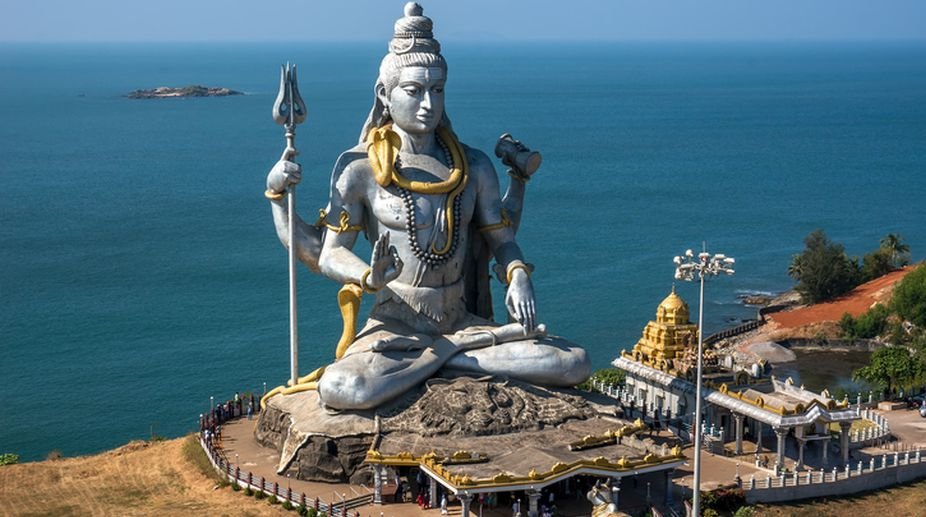
The sacred month of Sawan, also called Shravan Maas, holds deep spiritual significance in Hindu culture. Celebrated annually, this holy month is dedicated to Lord Shiva, one of the principal deities in Hinduism. Devotees across India and Nepal immerse themselves in devotion, fasting, prayer, and temple visits during this spiritually powerful time. Sawan is considered extremely auspicious for worship, meditation, and divine blessings. It is believed that worshipping Lord Shiva during this month brings peace, prosperity, and liberation from past sins.
Why is Sawan Celebrated? Mythological and Spiritual Importance
Sawan is celebrated to commemorate the cosmic event of Samudra Manthan, the churning of the ocean, which is one of the most powerful episodes in Hindu mythology. During this churning, a deadly poison known as Halahala emerged that had the potential to destroy the entire creation. To save the universe, Lord Shiva drank the poison and held it in his throat. This act turned his throat blue and earned him the name Neelkanth. This selfless deed made Lord Shiva the savior of the world, and hence, during the month of Sawan, his devotees express gratitude by observing fasts, performing rituals, and chanting his name.
Another important reason for celebrating this month is that it marks the divine union of Lord Shiva and Maa Parvati. According to legends, Maa Parvati observed rigorous penance and fasting during Shravan to win Lord Shiva as her husband. Pleased by her devotion, Lord Shiva accepted her as his consort. Therefore, unmarried women especially fast on Mondays during Sawan, praying for a life partner like Lord Shiva.
When Does Sawan 2025 Begin and End?
According to the Hindu calendar and Drik Panchang, Sawan 2025 will begin on July 11 and end on August 9. This one-month period is considered a time of divine purification and spiritual upliftment. The last day of Sawan in 2025 will coincide with Raksha Bandhan, which will be celebrated on August 9, making the occasion even more special for Hindu families across the world.
First Sawan Somwar Vrat in 2025
The first Sawan Somwar Vrat, which is a Monday fast observed by devotees of Lord Shiva, will fall on July 14, 2025. This day marks the beginning of the Somwar Vrat series, where devotees observe fasting every Monday of Sawan. They wake up early, take a holy bath, and visit temples to offer Jalabhishek to the Shivling. Devotees offer water, milk, Belpatra (Bel leaves), and Ganga jal to the deity and chant Om Namah Shivaya continuously. The energy in temples and homes reverberates with devotional chants, incense, and bells.
Full Sawan Somwar Calendar for 2025
This year, Sawan will have four Somwars (Mondays). The first Sawan Somwar Vrat will be observed on July 14, followed by the second on July 21, the third on July 28, and the fourth and final on August 4. These days are regarded as highly sacred, and many people even begin their Solah Somwar Vrat (sixteen consecutive Monday fasts) from the first Monday of Sawan, which continues over four months. These fasts are kept for fulfillment of wishes, especially for health, career growth, and marital bliss.
Different Regional Start Dates for Sawan 2025
The beginning of Sawan varies by region due to differences in the Purnimant and Amavasyant Hindu calendars. In North Indian states like Uttar Pradesh, Rajasthan, Bihar, Madhya Pradesh, Punjab, Chhattisgarh, Himachal Pradesh, and Uttarakhand, Sawan starts on July 11. However, in South Indian and Western states like Maharashtra, Gujarat, Goa, Karnataka, Andhra Pradesh, Telangana, and Tamil Nadu, it begins later on July 25. In Nepal and some parts of Himachal Pradesh and Uttarakhand, the month starts from July 16. Despite the variation in start dates, the devotion and rituals remain consistent across regions.
Shubh Muhurat and Puja Rituals in Sawan 2025
The most auspicious time for Shubh Muhurat to perform Shiva Puja during Sawan is during the Brahma Muhurat, which occurs in the early morning before sunrise. Devotees begin their day by bathing and wearing clean, preferably white clothes. They offer sacred items like Ganga water, cow milk, honey, curd, ghee, sugar, and Bel leaves on the Shivling. Chanting of Maha Mrityunjaya Mantra and Shiva Chalisa is considered spiritually uplifting during these rituals. Many devotees observe a strict fast, where they consume only fruits or a single meal made from vrat-friendly ingredients.
Performing Rudrabhishek, a special kind of Abhishek ritual done by priests, is also considered extremely powerful. This includes bathing the Shivling with Panchamrit (a mix of five items – milk, curd, honey, sugar, and ghee) and chanting Vedic mantras. It is believed that Shiva fulfills all desires of those who sincerely perform this puja during the month of Sawan.
What to Avoid During Sawan: Food and Lifestyle Restrictions
The month of Sawan is not just about rituals but also about maintaining mental purity and physical discipline. Devotees are advised to follow a strict vegetarian diet and avoid onion, garlic, non-vegetarian food, and alcohol. Many people also refrain from using leather products and smoking. Observing celibacy, maintaining truthfulness, and avoiding anger are also recommended during this time. These restrictions are not just spiritual in nature but also align with Ayurvedic practices during the monsoon season when digestion is weak and the immune system needs support.
It is also believed that donating milk or milk products during Sawan brings great merit and blessings. Many people feed the poor, distribute cold water, or offer free meals in Shiva temples. These acts of charity are said to multiply their spiritual rewards and cleanse past karmas.
How is Sawan Celebrated Across India?
In Varanasi, one of the holiest cities for Shaivites, the energy during Sawan is electrifying. The ancient Kashi Vishwanath Temple is decorated with flowers, and lakhs of devotees throng the ghats of River Ganga. The entire city echoes with Har Har Mahadev and Om Namah Shivaya. Kanwar Yatras are also a major highlight of this month. Kanwariyas, the barefoot devotees of Lord Shiva, carry water from holy rivers like the Ganga and walk for hundreds of kilometers to offer it to Shiva Lingas in their local temples.
In Jharkhand and Bihar, devotees visit the famous Baba Baidyanath Dham in Deoghar, which is one of the twelve Jyotirlingas in India. In Maharashtra, the Trimbakeshwar Temple in Nashik witnesses lakhs of pilgrims. In Nepal, the majestic Pashupatinath Temple becomes a hub of spiritual activity during Shravan.
Scientific Relevance of Fasting in Sawan
The month of Sawan also coincides with the monsoon season, when there is high humidity and low digestion power. Fasting during this time helps detoxify the body and improves metabolism. Ayurveda suggests that reducing food intake during the monsoon is beneficial, and Sawan fasting perfectly aligns with this principle. Consuming light, sattvic meals, staying hydrated, and focusing on prayers brings both spiritual and physical healing.
Sawan 2025 is a time to connect with your inner self, enhance spiritual growth, and seek the divine blessings of Lord Shiva. From July 11 to August 9, devotees should immerse themselves in the path of devotion, discipline, and self-purification. Whether you are observing the Somwar Vrat, visiting temples, performing Rudrabhishek, or simply chanting the name of Shiva at home, your sincere efforts will not go in vain. Let this Sawan be a journey of transformation, inner peace, and divine connection.May Lord Shiva bless everyone with health, happiness, and harmony this Sawan 2025.































